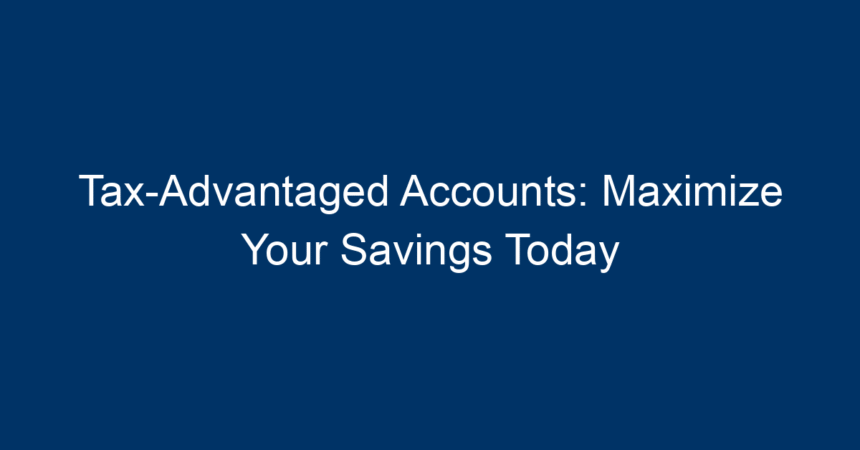In today’s fast-paced financial landscape, maximizing your savings is more crucial than ever. Whether you’re saving for retirement, a child’s education, or a major purchase, tax-advantaged accounts offer a strategic way to grow your wealth while minimizing tax liabilities. These accounts not only help you preserve your hard-earned money but also provide tools to reach your financial goals faster. In this comprehensive guide, we’ll explore the different types of tax-advantaged accounts, their benefits, and actionable strategies to get the most out of them.
What are Tax-Advantaged Accounts?
Tax-advantaged accounts refer to financial accounts that provide benefits in the form of tax deductions, tax-free growth, or tax-deferred growth. The government encourages saving for specific purposes through these accounts to promote financial security among individuals and families. By effectively utilizing these accounts, you can potentially save a significant amount of money over time.
The Importance of Tax-Advantaged Accounts
The primary reason tax-advantaged accounts are essential is the ability to grow your savings more effectively due to lower tax burdens. Depending on the account type, you may benefit from:
- Tax Deductions: Certain contributions may lower your taxable income.
- Tax-Free Growth: Earnings within the account may grow without tax implications until withdrawal.
- Tax-Deferred Growth: You only pay taxes when you withdraw funds.
Understanding these basic principles can help you leverage these accounts to your advantage.
Types of Tax-Advantaged Accounts
There are several types of tax-advantaged accounts to consider, each designed for specific savings goals. Let’s break down the most common ones:
1. Retirement Accounts
401(k) Plans
A 401(k) plan is an employer-sponsored retirement account that allows you to save for retirement while benefiting from tax advantages. Contributions are made pre-tax, reducing your taxable income for the year. Additionally, many employers offer matching contributions, which means free money to boost your savings.
- How to Maximize: Contribute at least enough to get the full employer match and aim to max out your contributions annually. For 2023, the contribution limit is $22,500, with an additional catch-up contribution of $7,500 if you’re over 50.
Traditional and Roth IRAs
A Traditional IRA provides tax-deferred growth, meaning you pay taxes when you withdraw money in retirement. In contrast, a Roth IRA allows for tax-free withdrawals in retirement as contributions are made after-tax.
- How to Maximize: Depending on your income and tax situation, choose one that aligns with your financial goals. For 2023, the IRA contribution limit is $6,500, with a $1,000 catch-up contribution if you’re over 50.
2. Health Savings Accounts (HSAs)
An HSA is a tax-advantaged account for individuals with high-deductible health plans (HDHPs) to save for medical expenses. Contributions are tax-deductible, grow tax-free, and withdrawals for qualified medical expenses are also tax-free.
- How to Maximize: Contribute the maximum allowed to leverage tax benefits. In 2023, the contribution limit is $3,850 for individuals and $7,750 for families, with an additional $1,000 for those aged 55 and older.
3. 529 College Savings Plans
A 529 Plan is designed to encourage saving for future education costs. Earnings grow tax-free, and withdrawals for qualified education expenses are also tax-free.
- How to Maximize: Start early to take advantage of compound growth and consider gifting contributions to maximize funding.
Why Choose Tax-Advantaged Accounts?
Choosing tax-advantaged accounts gives you a significant advantage when it comes to growing your finances. Here are some compelling reasons to prioritize these accounts:
1. Increased Investment Potential
By minimizing your tax burden, you have more money to invest, allowing your savings to grow more effectively over time.
2. Encouragement to Save
The incentives provided by tax-advantaged accounts motivate individuals to save for retirement, healthcare, or education. These accounts instill a savings habit that can lead to long-term financial security.
3. Flexibility in Withdrawals (in Certain Accounts)
While some accounts impose restrictions, others, like HSAs and Roth IRAs, offer more flexibility with tax-free withdrawals for qualified expenses.
How to Effectively Manage Your Tax-Advantaged Accounts
Managing multiple tax-advantaged accounts can be daunting. Here are some strategies to help you make the most of these accounts:
1. Create a Financial Plan
Establishing a comprehensive financial plan will allow you to assess your goals and allocate funds effectively. Identify your short-term and long-term objectives and allocate savings to the appropriate tax-advantaged accounts.
2. Monitor Your Accounts Regularly
Regularly reviewing your financial accounts is vital. Keep track of contribution limits, investment performance, and changing tax laws to ensure you are maximizing benefits.
3. Diversify Investments
Tax-advantaged accounts often allow for various investment choices. Diversifying your investments can help manage risk and improve potential returns.
4. Stay Informed on Tax Laws
Tax laws change frequently. Staying informed will enable you to adapt your strategy to maximize contributions and minimize taxes effectively.
Actionable Insights for Maximizing Tax-Advantaged Accounts
To truly maximize your savings through tax-advantaged accounts, consider the following actionable insights:
-
Start Early: The sooner you start contributing, the more you benefit from compounding growth and tax advantages.
-
Utilize Employer Matches: Always contribute enough to earn any employer match available in your 401(k) plan to maximize your employer contributions.
-
Set Contribution Reminders: Automate your contributions to ensure you’re regularly funding your accounts up to the annual limits.
-
Review Your Investment Strategies: Regularly assess your investment choices within these accounts to ensure they align with your risk tolerance and goals.
- Consult a Financial Advisor: A financial advisor can provide personalized insights and strategies to help you maximize your tax-advantaged accounts based on your financial situation.
Conclusion
Tax-advantaged accounts are invaluable tools that can drastically improve your financial wellbeing. By understanding the various types of accounts available and implementing effective management strategies, you can significantly maximize your savings today. Remember that each account serves a unique purpose and leveraging them effectively ensures you’re on the right path toward achieving your long-term financial goals. Start utilizing these accounts now and watch your savings grow!
By making informed choices today, you’ll enjoy a financially secure tomorrow. Whether it’s funding your retirement through a 401(k) or saving for your child’s education via a 529 plan, tax-advantaged accounts are essential for building a brighter financial future. Don’t wait—take action today!




